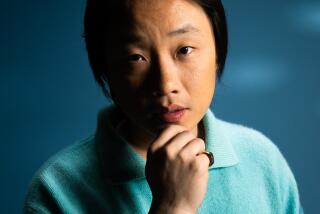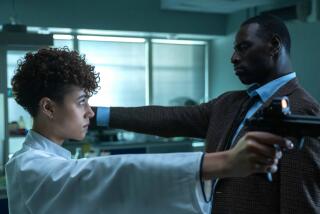John Woo revisits Chinese roots with ‘Red Cliff’
- Share via
Reporting from New York — “I’ve always wanted to be a global filmmaker,” John Woo said in an interview at his Manhattan hotel last month.
This cosmopolitan outlook was evident in the late ‘80s, when Woo galvanized Hong Kong cinema -- and action filmmaking the world over -- with such films as “A Better Tomorrow” and “The Killer.” Feverish gangster movies unencumbered by restraint or irony, they were also cross-cultural genre hybrids, combining the slow-motion violence of Sam Peckinpah, the trench-coat cool of Jean-Pierre Melville and the chivalric codes of martial-arts film and literature, even though Woo’s characters brandished guns and not swords.
An instant influence on discerning genre students in the West (Quentin Tarantino and the Wachowskis, to name only the most prominent), Woo soon set about adapting his poetic, hyperbolic style to the strictures of Hollywood. Starting in 1993, he made six American movies and a couple of TV movies, a run that peaked with the blockbusters “Face/Off” (1997) and “Mission: Impossible II” (2000).
After an extended absence -- his last feature was 2003’s “Paycheck,” a forgettable Philip K. Dick adaptation starring Ben Affleck -- Woo, now 63, completes the circle with his first Chinese film in 16 years, “Red Cliff,” a mythic slice of Chinese history brought to life with the sheer muscle of a Hollywood mega-production.
“Red Cliff,” which opens in Los Angeles on Wednesday, is Woo’s largest project yet, in scale if not budget. (It cost a reported $80 million, making it the most expensive Chinese-language film in history, but some of Woo’s Hollywood movies cost at least as much or more.) With its sweeping locations and swarming armies (partly digitized), it is the fulfillment of a longtime ambition, Woo said, “to make a movie like ‘Lawrence of Arabia,’ ‘Spartacus,’ and of course ‘Seven Samurai,’ something really epic.”
The movie recounts the Battle of the Red Cliffs among warring Chinese kingdoms in the early third century, a pivotal conflict immortalized in the 14th-century literary classic “Romance of the Three Kingdoms” and since retold and reimagined in a multitude of novels, comic books, TV series, films and video games.
Woo said it took 2 1/2 years to write the script, which he worked on with two other writers and which he admits freely deviates from both the original novel and historical accounts, which are themselves far from conclusive (“I was not making something for the History Channel,” he said). Preproduction took a year and a half, and the shoot lasted eight months.
In Asia, where it was released as two films totaling nearly five hours, “Red Cliff” has already grossed more than $120 million (in mainland China, part one has out-performed “Titanic”). American audiences will see about half of that: The international cut is a single 2 1/2 -hour movie that keeps the action largely intact but whittles down subplots and skimps on character development. (The full version will be released here next year on DVD.)
As it turns out, the “Red Cliff” legend, which Woo first encountered in comic form as a child, is a kind of sourcebook for his entire body of work. The military strategists (Tony Leung and Takeshi Kaneshiro) who bring the two weaker kingdoms together to thwart the advancing forces of the powerful third (led by Zhang Fengyi’s belligerent prime minister) form a male dyad familiar from many Woo films: underdog soul mates who overcome seemingly impossible odds through their profound brotherly bond.
“These were the heroes I admired as a child,” Woo said, referring to Leung and Kaneshiro’s characters. “They’re men who are loyal to their country and loyal to their friends. They have a much smaller army but they defeat a much stronger and more powerful enemy through the combination of teamwork, innovation, intelligence, confidence and courage.”
Woo first tried to make a movie about the Three Kingdoms more than 20 years ago but “we didn’t have the technology back then,” he said. Since then, he added, “I’ve learned so much” -- not least about the logistics of large-scale film production -- “and I thought it was about time to take what I learned in Hollywood to work in Asia.”
When he arrived in the States in the early ‘90s to direct the Jean-Claude Van Damme vehicle “Hard Target,” Woo was eager to get away from the breakneck pace of movie production in Hong Kong, where, he said, “people didn’t appreciate the filmmakers or the film business that much.”
But for someone accustomed to the seat-of-the-pants culture of the Hong Kong scene, it was hard to adapt to Hollywood filmmaking-by-committee. “I didn’t realize it took such a long time to set up a project or to make any kind of decision,” he said. Woo eventually found his footing, making a reasonably Woo-ian thriller with the outrageously premised “Face/Off” (in which John Travolta and Nicolas Cage switch faces), and seemed to stretch in a new direction with the relatively sober platoon drama “Windtalkers” (2002). But he missed “the real feeling of freedom,” he said, “where we work independently and we didn’t need to take notes from anyone.”
Woo hasn’t abandoned Hollywood -- he lives in Los Angeles and still has studio projects in development, including a film about Marco Polo and a remake of Melville’s “Le Samourai” (which he paid tribute to in “The Killer”). But his next movie, “Flying Tigers,” about volunteer American pilots who fought with the Chinese during World War II, will be filmed and likely financed in China.
Working in China has been a freeing experience for Woo. “All I said was I want to make a movie called ‘Red Cliff,’ ” he said, referring to his first meeting with the producers, “and they said OK, let’s do it!” But if Woo has never felt fully at home in Hollywood, it may ultimately be less a matter of work methods than artistic temperament. His style is so distinctive that it can be easily copied or reduced to signatures: balletic gunplay, flapping doves, meaningful looks in the desperate heat of battle. The thing that often doesn’t survive in his American work is the overwhelming sincerity, the unfashionable depth of feeling.
His best movies routinely risk ridicule, skirting the edge of cornball sentimentality, and Woo is no less earnest in person. He sees “Red Cliff” as, above all, an inspirational story, not least for the alienated youth of Asia.
“I’m an optimist,” he said. “Many young people are so frustrated now. I wanted to make an encouraging movie for them. I wanted to show them there is always a friend and always a hope.”
More to Read
Only good movies
Get the Indie Focus newsletter, Mark Olsen's weekly guide to the world of cinema.
You may occasionally receive promotional content from the Los Angeles Times.










